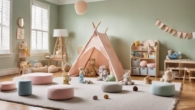
How to Create a Stress-Free Home Environment for Your Loved Ones
They create a stress-free home environment for their loved ones by decluttering and organizing living spaces, allocating space efficiently, and categorizing belongings. A calming color scheme, such as monochromatic neutrals or nature-inspired hues, can also promote relaxation. Minimizing noise and distractions, bringing in natural light and greenery, and establishing tech-free zones can further reduce stress. By implementing these strategies, they can transform their home into a serene oasis. As they continue on this path, they'll uncover even more ways to cultivate a haven that nurtures the well-being of those they care about.
Declutter and Organize Living Spaces
By stripping away clutter and chaos, individuals can transform their living spaces into serene oases that foster relaxation and reduce stress. A well-organized home environment can work wonders for one's mental health and overall well-being. To achieve this, it's essential to allocate space efficiently, ensuring each area serves a specific purpose. This can be achieved by categorizing belongings into three piles: keep, donate, and discard. Be ruthless – if an item hasn't been used in the past year, it's likely safe to let it go.
Implementing a habit tracking system can also help maintain a clutter-free space. Set aside time each week to tidy up and address any areas that need attention. This can be as simple as dedicating 10 minutes each morning to making one's bed or putting away dishes. By creating a routine, individuals can develop healthy habits that become second nature. Additionally, label storage containers and shelves to encourage family members to put things back in their designated place. By doing so, individuals can create a sense of calm and tranquility, allowing loved ones to feel more relaxed and centered in their living space. By allocating space thoughtfully and tracking habits, individuals can create an environment that nurtures mental well-being and promotes a sense of serenity.
Create a Calming Color Scheme
Three calming color palettes can instantly soothe the senses: monochromatic neutrals, soft pastels, and nature-inspired hues. These palettes can create a serene atmosphere, perfect for a stress-free home environment. To select the most calming colors for your space, consider creating a Mood Board. This visual tool allows you to experiment with different colors, textures, and patterns, ensuring a cohesive look that promotes relaxation.
Color Psychology plays a significant role in creating a calming color scheme. Research has shown that certain colors can influence our emotions and mood. For example, blue hues are known to induce feelings of calmness and trust, while green is associated with balance and harmony. By incorporating these colors into your design, you can create a peaceful ambiance that promotes relaxation.
When selecting a calming color scheme, consider the natural world. Earthy tones, such as sage green, sandy beige, and driftwood gray, can bring a sense of calmness into your home. These nature-inspired hues can create a sense of serenity, making your space feel like a tranquil oasis. By incorporating these calming colors into your design, you can create a stress-free home environment that nurtures the well-being of your loved ones.
Minimize Noise and Distractions
At least 30% of people experience noise-related stress, making it essential to minimize distractions and create a peaceful environment. A stress-free home should be a haven where loved ones can unwind and recharge. To achieve this, it's vital to minimize noise and distractions, allowing family members to relax and focus.
Soundproofing solutions can be an effective way to reduce external noise pollution, creating a more serene atmosphere. This can be achieved through the installation of sound-absorbing materials, such as acoustic panels or soundproofing blankets. Additionally, strategically placing furniture and decor can help to deflect and absorb sound, further reducing noise levels.
Creating quiet corners or designated areas for relaxation can also contribute to a peaceful environment. These areas can be designed to be free from distractions, providing a sense of calm and tranquility. This can be achieved by incorporating comfortable seating, calming colors, and minimal decor, allowing individuals to unwind and recharge.
Bring in Nature and Light
Natural light and lush greenery can transform a space, elevating mood and reducing stress levels, making it essential to bring the outdoors in. By incorporating elements of nature into the home, individuals can create a calming and peaceful atmosphere that promotes relaxation and well-being.
To achieve this, consider the following ways to bring in nature and light:
- Optimize Greenery Placement: Strategically place plants in areas where they can thrive, such as near windows or in sunrooms, to maximize natural light and purify the air.
- Utilize Natural Ventilation: Open windows and doors to allow fresh air to circulate, reducing the need for artificial air purifiers and promoting a sense of freshness.
- Incorporate Mirrors: Place mirrors opposite windows to reflect natural light and create the illusion of more space, making the room feel brighter and more expansive.
- Bring in Textures: Add natural textures such as woven baskets, jute rugs, and reclaimed wood furniture to create a cozy and organic atmosphere.
Establish a Tech-Free Zone
By designating a tech-free zone in the home, individuals can create a space that fosters meaningful interactions, relaxation, and rejuvenation. In today's digital age, it's essential to set boundaries and prioritize face-to-face connections. By establishing a tech-free zone, families can promote quality time, reduce screen time, and encourage more mindful interactions.
| Tech-Free Zone Ideas | Benefits |
|---|---|
| Designate a device-free dining area | Fosters meaningful conversations and strengthens family bonds |
| Create a screen-free living room | Encourages relaxation, reading, and other hobbies |
| Establish a phone-free bedroom | Promotes better sleep, reduces distractions, and improves relationships |
Frequently Asked Questions
How Can I Involve My Family in the Decluttering Process?
She involves her family in the decluttering process by making it a team effort. She schedules regular family meetings to discuss goals and assign tasks, ensuring everyone's on the same page. She creates chore charts, dividing responsibilities fairly, and encourages open communication. By working together, they tackle clutter hotspots, fostering a sense of ownership and teamwork. This collaborative approach not only declutters the space but also strengthens family bonds.
Can I Still Have a TV in a Tech-Free Zone?
She wonders if having a TV in a tech-free zone defeats the purpose. The answer lies in setting clear zone boundaries. If the goal is to reduce screen time, then perhaps a TV doesn't belong. However, if the zone is meant to be a relaxation space, a TV might be acceptable. It's essential to define the zone's purpose and set boundaries that work for everyone. By doing so, she can create a harmonious balance between tech and tranquility.
What if I Have Limited Natural Light in My Home?
When darkness descends, and natural light is scarce, she doesn't let it dim her spirits. Instead, she cleverly employs mirrored reflections to bounce and amplify any available light, creating a brighter atmosphere. Additionally, she incorporates artificial illumination, thoughtfully selecting warm, calming tones to mimic the soft glow of a sunny day. By doing so, she transforms her space into a serene oasis, perfect for relaxation and rejuvenation.
How Do I Handle Clutter From Sentimental Items?
She understands the emotional attachment to sentimental items, making it tough to part with them. To handle clutter from these items, she suggests creating Memory Boxes. These boxes allow her to store a few select items, like photos or heirlooms, while letting go of the rest. By doing so, she preserves the memories without sacrificing space or serenity.
Are There Any Specific Calming Scents for a Stress-Free Home?
Sarah's home, once a haven, had become overwhelming due to clutter and stress. She discovered the calming power of scents. Certain aromas, like lavender and vanilla, have a profound impact on stress levels. Incorporating essential oils into her daily routine, Sarah found solace in the calming atmosphere they created. She also lit scented candles, filling her home with soothing fragrances. By doing so, she crafted a serene environment, perfect for her loved ones to unwind.











